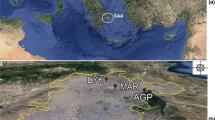Abstract
One-year series of hourly average air pollutant concentration(APC) observations, including O3, CO, SO2 and NO2,were analyzed by means of statistical tools: histogram, variancemethod, and multifractal analysis, to examine the possible scale-invariant behavior and the clustering characteristics. It was found that all APC measurements exhibit the characteristicright-skewed unimodal frequency distribution and long term memory. A monodimensional fractal analysis was performed by thebox counting method. Scale invariance was found in these time series and the box dimension was shown to be a decreasing function of the threshold APC level, implying multifractal characteristics, i.e., the weak and intense regions scaledifferently. To test this hypothesis, the APC time series weretransferred into a useful compact form through the multifractalformalism, namely, the τ(q)-q and f(α)-α plots. The analysis confirmed the existence of multifractal characteristics in the investigated APC time series. It wasconcluded that the origin of both the pronounced right-skewnessand multifractal phenomena in APC time series may be interpretedin terms of the Ott (1995) proposed successive random dilution (SRD) theory and the dynamics of APC distribution process can bedescribed as a random multiplicative process.
Similar content being viewed by others
References
Anh, V. V., Lam, K. C., Leung, Y. and Tieng, Q. M.: 2000, ‘Multifractal Analysis of Hong Kong Air Quality Data’, Environmetrics 11, 139–149.
Bencala, K. E. and Seinfeld, J. H.: 1976, ‘On Frequency Distribution of Air Pollutant Concentrations’, Atmos. Environ. 10, 941–950.
Borgas, M. S.: 1992, ‘A Comparison of Intermittency Models in Turbulence’, Phys. Fluids A 4, 2055–2061.
Buczkowski, S., Hildgen, P. and Cartilier, L.: 1998, ‘Measurements of Fractal Dimension by Box-counting: A Critical Analysis of Data Scatter’, Physica A 252, 23–34.
Bunde, A. and Havlin, S.: 1994, Fractals in Science, Springer-Verlag, Berlin, 17 pp.
Chock, D. P., Terrell, T. R. and Levitt, S. B.: 1975, ‘Time-series Analysis of Riverside, California Air Quality Data’, Atmos. Environ. 9, 978–989.
Davis, A., Marshak, A., Wiscombe, W. and Cahalan, R.: 1994, ‘Multifractal Characterizations of Nonstationarity and Intermittence in Geophysical Fields: Observed, Retrieved, or Simulated’, J. Geophys. Res. 99, 8055–8072.
Falconer, K.: 1990, Fractal Geometry: Mathematical Foundations and Applications, John Wiley & Sons, Chichester, 288 pp.
Frisch, U.: 1995, Turbulence, Cambridge University Press, Cambridge, 171 pp.
Georgopoulos, P. G. and Seinfeld, J. H.: 1982, ‘Statistical Distributions of Air Pollutant Concentrations’, Environ. Sci. Technol. 16, 401A–416A.
Godano, C., Alonzo, M. L. and Vilardo, G.: 1997, ‘Multifractal Approach to Time Clustering of Earthquakes. Application to Mt. Vesuvio Seismicity’, Pure Appl. Geophys. 149, 375–390.
Gonzato, G., Mulargia, F. and Marzocchi, W.: 1998, ‘Practical Application of Fractal Analysis: Problems and Solutions’, Geophys. J. Int. 132, 275–282.
Gutfraind, R., Sheintuch, M. and Avnir, D.: 1991, ‘Fractal and Multifractal Analysis of the Sensitivity of Catalytic Reactions to Catalyst Structure’, J. Chem. Phys. 95, 6100–6111.
Hasley, T. C., Jensen, M. H., Kadanoff, L. P., Procaccia, I. and Shraiman, B. I.: 1986, ‘Fractal Measures and Their Singularities: The Characterization of Strange Sets’, Phys.Rev. A 33, 1141–1152.
Horowitz, J. and Barakat, S.: 1979, ‘Statistical analysis of the Maximum Concentration of an Air Pollutant: Effects of Autocorrelation and Non-stationarity’, Atmos. Environ. 13, 811–818.
Klement, S. and Kratky, K. W.: 1997, ‘Multifractal Analysis of Airborne Particle Count Data: The Influence of Data Preprocessing’, Aerosol Sci. Technol. 26, 12–20.
Klement, S., Nittman, J., Kratky, K. W. and Actio, W. P.: 1994, ‘Multifractal Analysis of Airborne Microcontamination Particles’, Aerosol Sci. Technol. 20, 100–110.
Ladoy, P., Lovejoy, S. and Schertzer, D.: 1991, ‘Extreme Variability of Climatological Data: Scaling and Intermittency’, in S. Lovejoy and D. Schertzer (eds), Non-linear Variability in Geophysics, Kluwer Academic Publishers, Norwell, MA, pp. 241–250.
Lee, C. K. and Lee, S. L.: 1996, ‘Heterogeneity of Surfaces and Materials, as Reflected in Multifractal Analysis’, Heterogen. Chem. Rev. 3, 269–302.
Mandelbrot, B. B.: 1982, The Fractal Geometry of Nature, Freeman, San Francisco.
Meneveau, C. and Sreenivasan, K. R.: 1991, ‘The Multifractal Nature of Turbulent Energy Dissipation’, J. Fluid Mech. 224, 429–484.
Olsson, J.: 1996, ‘Validity and Applicability of a Scale-independent, Multifractal Relationship for Rainfall’, Atmos. Res. 42, 53–65.
Olsson, J. and Niemczynowicz, J.: 1996, ‘Multifractal Analysis of Daily Spatial Rainfall Distributions’, J. Hydrol. 187, 29–43.
Olsson, J., Niemczynowicz, J. and Berndtsson, R.: 1993, ‘Fractal Analysis of High-resolution Rainfall Time Series’, J. Geophys. Res. 98, 23265–23274.
Olsson, J., Niemczynowicz, J., Berndtsson, R. and Larson, M.: 1992, ‘An Analysis of the Rainfall Time Structure by Box Counting-Some Practical Implications’, J. Hydrol. 137, 261–277.
Ott, W. R.: 1990, ‘A Physical Explanation of the Lognormality of Pollutant Concentrations’, J. Air and Waste Manage. Assoc. 40, 1378–1383.
Ott, W. R.: 1995, Environmental Statistics and Data Analysis, Lewis, Boca Raton, 191 pp.
Pfeifer, P. and Obert, M.: 1989, ‘Fractals: Basic Concepts and Terminology’, in D. Avnir (ed.), The Fractal Approach to Heterogeneous Chemistry, John Wiley & Sons, New York, pp. 11–51.
Rodriguez-Iturbe, I., De Power, B. F., Sharifi, M. B. and Georgakakos, K. P.: 1989, ‘Chaos in Rainfall’, Water Resour. Res. 25, 1667–1675.
Stanley, H. E. and Meakin, P.: 1988, ‘Multifractal Phenomena in Physics and Chemistry’, Nature 335, 405–409.
Teverovsky, V. and Taqqu, M.: 1997, ‘Testing for Long-range Dependence in the Presence of Shifting Means or a Slowly Declining Trend, Using a Variance-type Estimator’, J. Time Ser. Anal. 18, 279–304.
Vicsek, T.: 1992, Fractal Growth Phenomena, World Scientific, Singapore, 81 pp.
Author information
Authors and Affiliations
Corresponding author
Rights and permissions
About this article
Cite this article
Lee, CK. Multifractal Characteristics in Air Pollutant Concentration Time Series. Water, Air, & Soil Pollution 135, 389–409 (2002). https://doi.org/10.1023/A:1014768632318
Issue Date:
DOI: https://doi.org/10.1023/A:1014768632318




